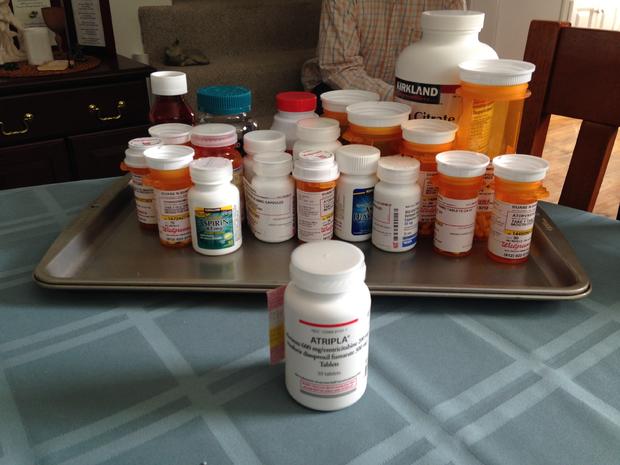For HIV/AIDS Patients In Minnesota, The Fight Is Far From Over
MINNEAPOLIS (WCCO) -- Inside a small, south Minneapolis home with a rainbow flag flying proudly on its door, 55-year-old AIDS patient Duane Bandel is finding a small piece of relief. It's Wednesday, and one of the only days of the week where he doesn't have an appointment with any of the doctors and health specialists that help keep him alive and comfortable. But living with AIDS, that doesn't mean it's a day without worry.
Jim Lawser, Bandel's partner of nearly 30 years, brings out a tray from the kitchen covered in dozens of bottles of pills. Bandel says he takes at least one pill from each bottle every day to manage his illness.
"Right now I'm taking 20 pills a day," Bandel said. "For a while I was taking, like, 33, 34 pills a day."
Despite the small metropolis of pill bottles on the table, only one of them manages the disease itself. The rest, he says, are to manage the constant barrage of symptoms -- diarrhea, nausea, fatigue and neuropathy, which can cause intense pain in his legs.
Still, the incessant regimen is in stark contrast to the harsh realities the AIDS epidemic of decades past. Many remember a time not long ago when a diagnosis was nothing short of a death sentence.
Yet with all the progress made in the fight against its mortality, AIDS and HIV still manage to consume lives.
"I think if I were to describe my life, it would be a person living with HIV first, and the rest of me follows," Bandel said.
Bandel is among some 8,200 people in Minnesota living with HIV or AIDS. Despite their constant struggle, Bandel and others feel the general public has already declared victory over the disease, as medical research has made incredible strides over the past few decades as mortality rates sharply declined.
Andy Birkey is with the Minnesota AIDS Project, which helps patients and families struggling with the disease.
"Until about 1996, a lot of the work we did was end-of-life care -- helping people with housing, delivering meals," he said. "We had a buddy program that would go out and just help people with housework, get around to appointments and stuff like that."
But while the death rate has dropped, so too has public interest. Bandel says education and outreach, which are crucial to preventing infection, are disappearing. Where national holidays and outreach events once consumed the public's collective attention, now they're only a small blip on the radar.
"The Minnesota AIDS Walk used to be a big thing, and now nobody knows what it is," he said. "In fact, this year they didn't even do it. It's like everybody's kind of given up."
While the death rate may have slowed, infection rates barely lost any ground. Recently released data from the Minnesota Department of Health show 294 people were diagnosed with HIV or AIDS in 2015, and that number has largely remained the same for the past decade.
New infections are also disproportionately among young people and communities of color. Activists say those groups are least prepared to deal with the disease.
"The communities that are most impacted are the communities that have the least access to employment, healthcare, all of that stuff," Birkey said. "We know that poverty is very closely tied with HIV -- not only new infections, but also mortality."
In Bandel's case, he was lucky. As a case worker for MinnesotaCare -- the state's public health insurance program for low-income residents -- he knew how to navigate the complex and confusing world of health insurance.
He went on to become an HIV/AIDS insurance specialist at the Minnesota Department of Human Services, where he saw how hard things can get for other patients.
"A lot of the people I worked with didn't have money. Some people didn't have permanent housing. They didn't have a support group at all. I knew a few people that were my clients that lived in northern Minnesota, and they would drive to Minneapolis every month for their pills because they didn't want their local pharmacist to know they had HIV," Bandel said. "There are some people who are new to the country and don't understand insurance -- they've never had it before."
Stories of the disease's toll can be disheartening, but activists say the war against HIV and AIDS is winnable. According to a 2012 study by the Centers for Disease Control, many states saw a drop in infection rates after implementing more comprehensive sex education in public schools, and Birkey says that's no coincidence.
"We're seeing this increase every year among young people, and if we're not teaching them how not to become infected with HIV, we shouldn't be surprised when they do," he said.
Bandel, too, has been doing his part to spread awareness. Since retiring from his job, he's been an outspoken activist in the local fight on AIDS, and tells his story to students at three Twin Cities high schools each year.
"I think there's just a lack of general education. Nobody talks about HIV in Minnesota. It's the thing that I've been fighting since I got my diagnosis," he said. "I want to educate people."
-------------
For more on what it's like to live with AIDS in Minnesota, you can read Duane Bandel's blog. For more on the biology, prevention and treatment of the disease -- and for a more detailed look at the state's infection statistics -- visit the Minnesota Department of Health's website.
Bandel is also on Gov. Mark Dayton's task force on medical marijuana, but still hasn't been able to be prescribed the drug himself, as WCCO's Angela Davis reported last year.





